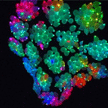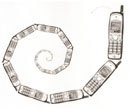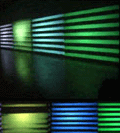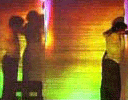September 05, 2004
Work by Usman Haque
Usman Haque designs interactive architecture systems and researches how people relate to each other and their spaces. "The domain of architecture has been transformed by developments in interaction research, wearable computing, mobile connectivity, people-centered design, contextual awareness, RFID systems and ubiquitous computing. These technologies alter our understanding of space and change the way we relate to each other. We no longer think of architecture as static and immutable; instead we see it as dynamic, responsive and conversant. Our projects explore some of this territory." Performative works include:
 Sky Ear, 2004: This non-rigid "cloud", made up of several hundred glowing helium balloons will be embedded with mobile phones. As visitors to the event call into the cloud to listen to the distant electromagnetic sounds of the sky (including whistlers and spherics), their mobile phone calls will change the local hertzian topography; these disturbances in the electromagnetic fields inside the cloud will alter the glow intensity of that part of the balloon cloud. Quicktime video: 19 MB
Sky Ear, 2004: This non-rigid "cloud", made up of several hundred glowing helium balloons will be embedded with mobile phones. As visitors to the event call into the cloud to listen to the distant electromagnetic sounds of the sky (including whistlers and spherics), their mobile phone calls will change the local hertzian topography; these disturbances in the electromagnetic fields inside the cloud will alter the glow intensity of that part of the balloon cloud. Quicktime video: 19 MB
 Japanese Whispers, Tokyo (2000): Similar to the children's game known as "Chinese Whispers" or "The Telephone Game," this project looks at how a message is changed by being passed from one mechanism to another--in this case the cellphone.
Japanese Whispers, Tokyo (2000): Similar to the children's game known as "Chinese Whispers" or "The Telephone Game," this project looks at how a message is changed by being passed from one mechanism to another--in this case the cellphone.
Cellphones are laid in a circle and calls are initiated from one phone to another in a variety of patterns with differing results. The sound degrades at each step as it is transformed from analog to digital and back again, emphasising the circular nature of communication. The iterative process of the feedback loop amplifies miscommunications inherent in the transmitting of information. Quicktime video: 9.2 MB
 Infinitum Ad Nauseam, Tokyo (2000): The project is a video/audio performance installation which requires the explicit participation of the audience. Essentially, the system uses video and audio feedback to create sounds (from images and movements) and images (from sounds and movements). 4 video cameras, 4 video projectors, 2 video mixers and an audio mixer are used to initiate a massive feedback loop of video-video, video-audio, audio-video and audio to audio. This creates dynamic real-time images and sounds in "conversation" with the visitors or performers. There are no pre-recorded images and no computerised images used in the installation. Videos>>
Infinitum Ad Nauseam, Tokyo (2000): The project is a video/audio performance installation which requires the explicit participation of the audience. Essentially, the system uses video and audio feedback to create sounds (from images and movements) and images (from sounds and movements). 4 video cameras, 4 video projectors, 2 video mixers and an audio mixer are used to initiate a massive feedback loop of video-video, video-audio, audio-video and audio to audio. This creates dynamic real-time images and sounds in "conversation" with the visitors or performers. There are no pre-recorded images and no computerised images used in the installation. Videos>>
 Changing Faces of Gesture, Tokyo (2000) with Charlotte Boye-Christensen (Choreographer/Dancer): The performance consists of one person and 2 to 4 large video projections. Using a simple video feedback system (where a video camera is pointed towards the screen upon which its image is being projected) coupled with an audio feedback system, complex images are created in realtime which are manipulated by the performer's movements. Images created resemble reflections in a puddle; these can be coloured using filters on both the cameras and the video-projectors. Furthermore each projector can be separately controlled to multiply the effects and simulate everything from a solitary dancing figure to a bustling crowd of people. Videos>>
Changing Faces of Gesture, Tokyo (2000) with Charlotte Boye-Christensen (Choreographer/Dancer): The performance consists of one person and 2 to 4 large video projections. Using a simple video feedback system (where a video camera is pointed towards the screen upon which its image is being projected) coupled with an audio feedback system, complex images are created in realtime which are manipulated by the performer's movements. Images created resemble reflections in a puddle; these can be coloured using filters on both the cameras and the video-projectors. Furthermore each projector can be separately controlled to multiply the effects and simulate everything from a solitary dancing figure to a bustling crowd of people. Videos>>
Posted by jo at September 5, 2004 11:42 AM
Comments
"Mobile phones are not only communication tools, but also sensors of the invisible electromagnetic environment that surrounds us, making us aware of what has been called "hertzian" space. London-based architect Usman Haque, who designs interactive architecture systems and researches how people relate to each other and their spaces, introduces us to hertzian space: his art project "Sky Ear" reveals the richness of our electromagnetic habitat."From Invisible Topographies by Usman Haque http://www.receiver.vodafone.com/09/articles/index02.html
Posted by: Jo at September 16, 2004 06:21 PM
Latest Sky Ear flight: http://haque.co.uk/skyear/images-040915.html
Posted by: Jo at September 24, 2004 05:34 PM
